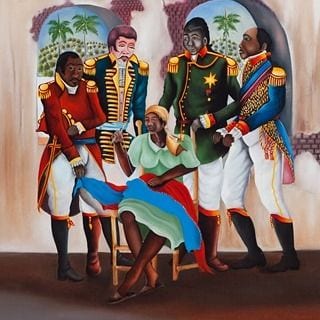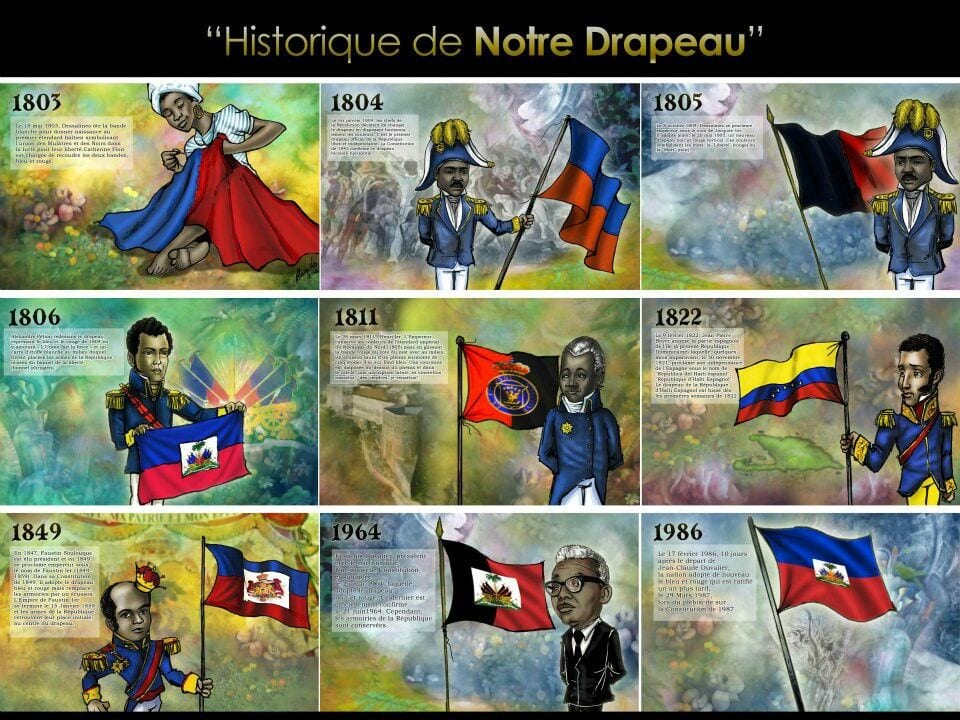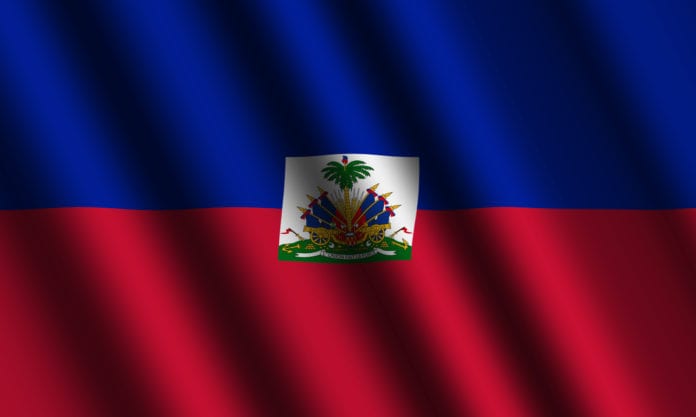The modern Haiti Flag contains two horizonal color bands. The top horizontal band is blue and the bottom horizontal band is red. In the middle of the flag, there is a white panel with the “coat of arms” image in it. The coat of arms is a symbol of liberty and independence.
Haiti first introduced the coat of arms in 1807, which was a few years after the country gained its independence from France. The coat of arms appears as three red and blue flags draped down to the right and another three red and blue flags draped down to the left. The three flags on each side face away from a palm tree that is in the middle of them.
On top of the palm tree is a Phrygian cap, which is the liberty cap and a symbol of freedom in the Haitian culture. All six flags resemble the original Haitian flag that existed between the years 1807 and 1986. The white ribbon on the bottom of the coat of arms bears the words “L’Union fait la Force,” which is French for “Unity Makes Strength.”

Haitian Flag Day
Haitian Flag Day is a very big holiday to the people of Haiti. It is a day when Haitians celebrate their independence from France. As you might know, the French enslaved the Haitians for nearly 200 years before the slaves rebelled against their captors and fought for independence. The Haitian Revolution from 1791 to 1804 led to the country of Haiti being established and the Haitian people being free.
The first Haitian flag was introduced on May 18th, 1803. Haitian Flag Day has been celebrated on May 18th of every year since 1803. Up until that point, the French flag was the primary flag used on the Caribbean island of Hispaniola. The French flag, of course, consists of three vertical color bands: blue, white and red. It was the flag waved in the Saint-Domingue colony, which would become modern day Haiti.

History of the Haitian Flag
Jean-Jacques Dessalines, who was the leader of the freed slave revolutionary army, destroyed the tricolored French flag in 1803. He had Catherine Flon, who was his goddaughter, stitched a new flag together for what would become an independent country. Her version of the flag took out the white vertical stripe and just included the red and blue vertical stripes.
By leaving out the white color, it was meant to symbolize freedom for the people of color from their former white slaveowners and colonists. The blue and red colored bands together also symbolized the unity amongst the African Haitians and the mulatto Haitians. Since mulattoes were used to having more freedom than fully African Haitians, now they were considered equal to each other. That is what the blue and red colors together represent on the flag.
Haiti didn’t even officially declare its independence until January 1st, 1804. Once it did, Haiti became the first nation in the world to have former slaves at the head of its government. Dessalines declared himself to be the new emperor of Haiti as outlined in the Haitian constitution that was written previously.

Once Dessalines came into power, he changed the colors of the flag to black and red in 1805. However, the black and red version did not last for very long. On October 17th, 1806, Dessalines was assassinated but the circumstances of the incident are not clear to historians. There was a civil war between members of the Haitian government, so it might have had something to do with that.
After Dessalines’ death, a member of his administration named Alexandre Sabès Pétion became the first President of Haiti. The constitution was modified so that the country would have presidents instead of emperors. He also changed it so that he could become president for life instead of having to serve term limits. In any case, Pétion changed the flag colors back from black and red to blue and red. Only this time, the blue and red bands would become horizontal instead of vertical. It has stayed that way in some capacity ever since.
The longest duration for any Haitian flag was the one that existed between 1859 and 1964. It looks very similar to the one we have today. It is a flag with blue and red horizontal bands with a coat of arms in the middle. The difference is the white panel with the coat of arms looks a lot smaller now than it did back then. The classic coat of arms image took up significantly more room on the flag.
In 1964, Haitian President François Duvalier changed the appearance of the flag to have less height and more width. He also changed the horizontal band colors back to black and red again, but he did leave the coat of arms image in the middle. He only had the colors of the flags in the image changed to black and red. After he did in April of 1971, his son Jean-Claude Duvalier took over as president until 1986. He kept the flag colors the same within that time.
Duvalier was supposed to be president for life, but he fled Haiti after the government under his leadership collapsed. The next in line for the presidency was Henri Namphy of the National Council of Government. Once he came into power, the Haitian flag was modified to have blue and red horizontal bands with a smaller coat of arms in the middle. The flag has remained that way ever since 1986.

